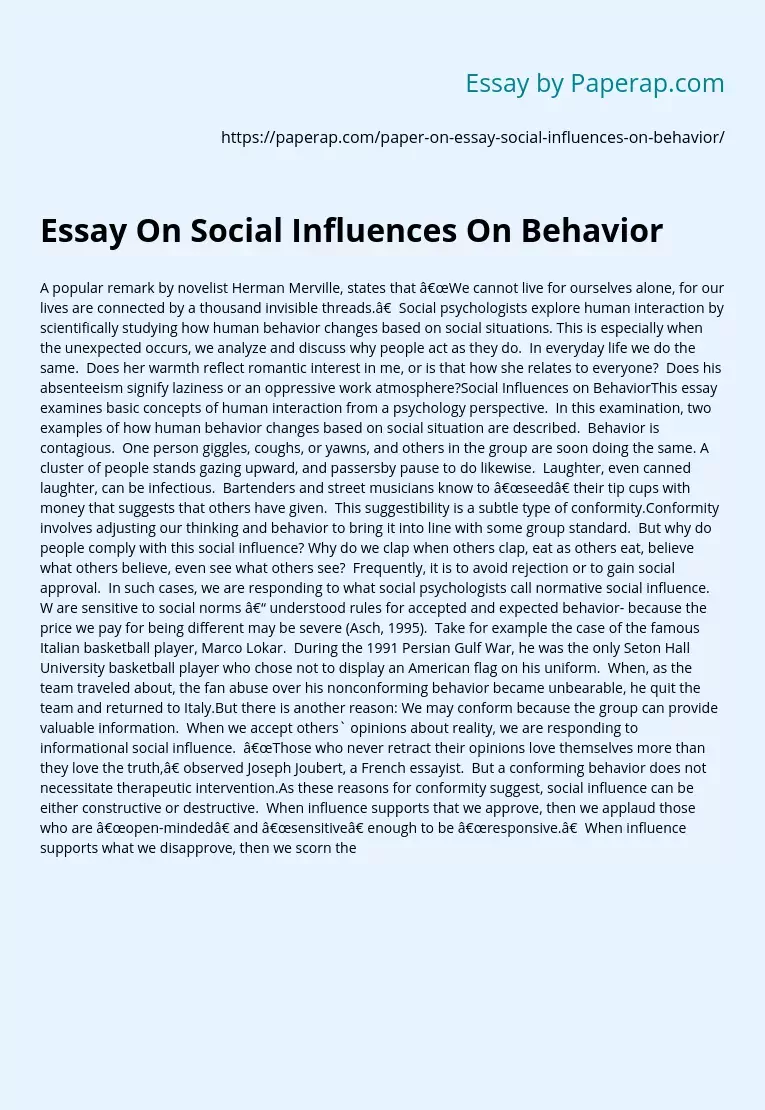Essay On Social Influences On Behavior
A popular remark by novelist Herman Merville, states that “We cannot live for ourselves alone, for our lives are connected by a thousand invisible threads.” Social psychologists explore human interaction by scientifically studying how human behavior changes based on social situations. This is especially when the unexpected occurs, we analyze and discuss why people act as they do. In everyday life we do the same. Does her warmth reflect romantic interest in me, or is that how she relates to everyone? Does his absenteeism signify laziness or an oppressive work atmosphere?Social Influences on BehaviorThis essay examines basic concepts of human interaction from a psychology perspective.
In this examination, two examples of how human behavior changes based on social situation are described. Behavior is contagious. One person giggles, coughs, or yawns, and others in the group are soon doing the same. A cluster of people stands gazing upward, and passersby pause to do likewise.
Laughter, even canned laughter, can be infectious. Bartenders and street musicians know to “seed” their tip cups with money that suggests that others have given. This suggestibility is a subtle type of conformity.Conformity involves adjusting our thinking and behavior to bring it into line with some group standard. But why do people comply with this social influence? Why do we clap when others clap, eat as others eat, believe what others believe, even see what others see? Frequently, it is to avoid rejection or to gain social approval.
In such cases, we are responding to what social psychologists call normative social influence. W are sensitive to social norms – understood rules for accepted and expected behavior- because the price we pay for being different may be severe (Asch, 1995). Take for example the case of the famous Italian basketball player, Marco Lokar. During the 1991 Persian Gulf War, he was the only Seton Hall University basketball player who chose not to display an American flag on his uniform. When, as the team traveled about, the fan abuse over his nonconforming behavior became unbearable, he quit the team and returned to Italy.But there is another reason: We may conform because the group can provide valuable information. When we accept others` opinions about reality, we are responding to informational social influence. “Those who never retract their opinions love themselves more than they love the truth,” observed Joseph Joubert, a French essayist. But a conforming behavior does not necessitate therapeutic intervention.As these reasons for conformity suggest, social influence can be either constructive or destructive. When influence supports that we approve, then we applaud those who are “open-minded” and “sensitive” enough to be “responsive.” When influence supports what we disapprove, then we scorn the “submissive conformity” of those who comply with others` wishes. Conformity is associated by such group phenomena as group think, minority influence, group polarization and social facilitation.Further, conformity studies reveal that conformity increases when: (1) We are made to feel incompetent or insecure; (2) The group has at least three people. (Further increases in the group size do not yield much increase in conformity); (3) The group is unanimous. (The support of a single fellow dissident greatly increases our social courage); (4) We admire the group’s status and attractiveness ;( 5) We have made no prior commitment to any response; (6) Others in the group observe our behavior; (7) Our culture strongly encourages respect for social standards (Gould,1991).Closely related to conformity is obedience. In our everyday life, we are always confronted to choose between holding to our own standards and being responsive to others, that is to obey. The most famous and controversial experiment on obedience was conducted by social psychologist Stanly Milgram. In this experiment, subjects were torn between what they respond to-the please of the victim or the orders of the experimenter. Their moral sense warned them not to harm another, but also prompted them to obey the experimenter and to be a good subject. With kindness and obedience on a collision course, obedience usually won. This experiment demonstrates that social influences can be strong enough to make people conform to the desired behavior. “The most fundamental lesson of this study,” Milgram noted, is that “ordinary people, simply doing their jobs, and without any particular hostility on their part, can become agents in terrible destruction process.” In analyzing this behavior, Milgram entrapped his subjects by exploiting the foot-in-the-door effect, or the tendency for people who have first agreed to a small request to comply later with a larger request, and thus obeyed the order of the experimenter but being obedient does not necessarily needs therapeutic intervention.Further, this behavior is associated with the minority influence phenomena. The experimenter as a minority influences over the subjects as the subjects obeyed. Moreover, obedience was highest when: (1) The one giving the orders is close at hand and perceived as a legitimate authority figure; (2) the authority figure is supported by legitimate institution; and (3) There were no role models for defiance; that is, there were no other subjects seen disobeying the experimenter (Milgram, 1994).ConclusionOverall, according to some psychologists, one of social psychology’s great lessons is the enormous power of social influence on behavior. Suicides, bomb threats, airplane hijackings, and UFO sightings all have a curious tendency to come in waves. Hence, armed with principles social influence, advertisers and salespeople aim to sway our decisions to buy, to donate, to vote. Thus, social influence on behavior is a potent social force.
Essay On Social Influences On Behavior. (2019, Dec 05). Retrieved from https://paperap.com/paper-on-essay-social-influences-on-behavior/

